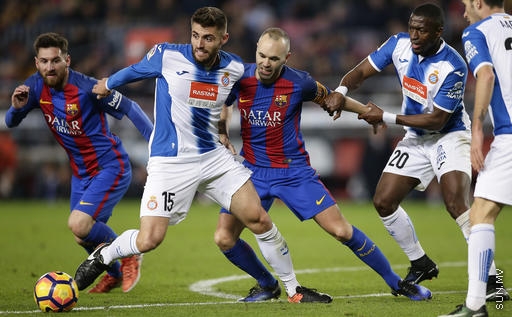
GENEVA (AP) — FIFA has detailed how it could expand the World Cup in a 64-page analysis of five options for the future of its signature tournament.
The document, seen by the Associated Press, was sent this week to FIFA Council members who on Jan. 10 should decide the shape of the 2026 World Cup.
Though retaining the 32-team format is on the table, FIFA and president Gianni Infantino are clearly committed to change.
Infantino believes a 48- or 40-team tournament would increase World Cup fervor in relatively new markets — many of whom voted for him February.
"The FIFA World Cup as a pull factor for development, offering a reward to increased investment and focus on football development locally, is significant," the research document says.
More teams and more matches also mean higher commercial sales to help FIFA fund itself and its 211 member federations.
Here are some of FIFA's arguments for and against the five options:
___
48 TEAMS — 16 GROUPS OF 3
The preferred option, announced by Infantino just this month.
The 16x3 format "offers the certainty of at least two matches per team, avoids any post-play-off let-down periods and, importantly, achieves all of this while retaining the authenticity of the current 32-team format by staying true to the traditional, purist football knockout format," the document said.
Each of the 80 matches in 32 days has an exclusive time slot — a rise on the current 56 live slots, where the last round of games in each group kicks off at the same time to guard against collusion.
Purists, however, are unlikely to enjoy the idea of penalty shootouts to decide drawn group-stage games. That is to protect against teams colluding on a favorable result that would let both advance to the new Round of 32.
So, fewer "dead rubber" group-stage matches and extra knockout games.
"Direct elimination of the last 32 teams would create drama and this 'life-or-death' format should therefore have a positive impact on audiences," FIFA suggests.
Audiences also get four daily matches in an intense first 16 days. The first rest day arrives only when the quarterfinals lineup is set.
Compared to $5.5 billion for the next World Cup in Russia, FIFA projects this format would earn the equivalent of $6.5 billion — the most lucrative option.
Organizing costs would also rise, from $2 billion to $2.3 billion, though at least $128 million of that is basic prize money to the 16 extra teams.
Hosts would still be required to provide a maximum of 12 stadiums, as Russia has chosen.
FIFA projects more revenue, happier commercial partners and more engaged fan bases worldwide.
"The most tangible and intangible value," FIFA's document said.
___
48 TEAMS — OPENING 32-TEAM PLAYOFF ROUND
Infantino's big idea of three months ago to get to 48 teams has probably found too much opposition to succeed.
It also has 80 matches, plus a round of 32 of undoubted high drama— just not where teams, fans and broadcasters want it.
The opening playoff round — of 32 teams playing a "one-and-done" match to join 16 seeded teams — has been viewed as not part of the real World Cup.
FIFA points to "post playoff let-down" and seems against taking that risk.
"The 48-team (16x3) format with a 2-match guarantee per team makes it the most attractive option," FIFA suggested.
The 4-day playoff round, plus three rest days ahead of a typical 32-teamm group stage would mean a 39-day tournament.
Teams and fans of some teams would either be making travel and ticket plans at short notice or leaving as others arrive for the main event
There is also uncertainty about how many teams from each continent would survive to the groups.
Even the promise of $6.32 billion revenue is likely not enough.
___
40 TEAMS — 10 GROUPS OF 4
The numbers don't add up.
Fewer matches, at 76, and a lop-sided bracket where only six of the 10 group runners-up would advance to a Round of 32.
"Any expanded format would present some issues which need to be addressed regarding sporting balance," FIFA said, with this flawed format in mind.
Unbeaten second-place teams in tough groups could be going home through no fault of their own, if their goal difference was inferior to runner-up from a weaker group.
Also, FIFA projects an increased profit of less than $200 million relative to the 2018 budget. The favored 16x3 format cashes in at $640 million increased profit.
___
40 TEAMS — 8 GROUPS OF FIVE
The flabbiest option.
The most matches, 88, but too few of them are meaningful.
In the 10,000 tournament simulations FIFA performed, it scored worst in terms of the pure quality of well-matched good teams playing each other.
"Both 48-team formats outperform the 40-team formats, with the 40-team (8x5) clearly the weakest format in this respect," FIFA said.
Also, the eight-match program required to win, or even reach the semifinals, is a nonstarter.
It is unacceptable to European clubs to release their salaried players for a longer stint of national-team duty.
___
32 TEAMS
If not perfect, certainly a proven and popular success since it was introduced at the 1998 World Cup in France.
The 64-match bracket is perfect: Two teams advance from each group into a Round of 16.
"The format with the highest absolute quality (of play) would be achieved under the current format," FIFA acknowledged.
But change has been promised to FIFA members in two separate votes last Feb. 26 in Zurich.
They elected a president who campaigned on offering more invitations to the World Cup party, and they approved anti-corruption FIFA reforms sweetened by the promise of more, and lucrative, World Cup places.
That reform panel which suggested that included Infantino and the now-FIFA vice president Victor Montagliani of Canada — a potential co-host in 2026 with the United States and Mexico.